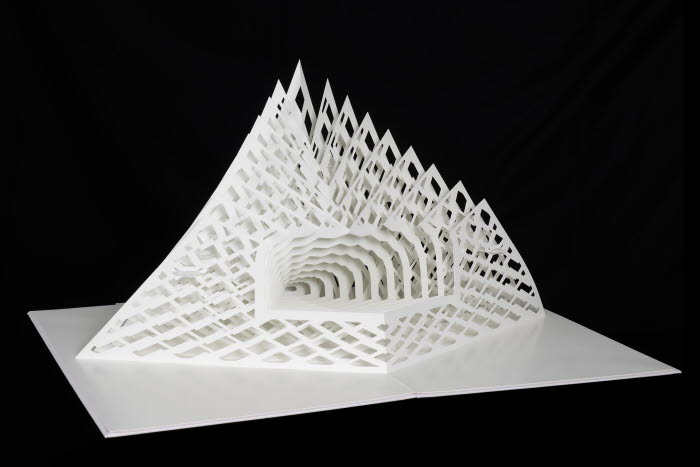About two years ago, the composer and producer of a new children’s opera,” Saltice – A Fairytale of Salt and Ice”, Ruben Zahra, contacted renowned 3D pop-up paper artist Peter Dahmen. Zahra had been inspired by Dahmens’ work and asked him to design five stage sets for the opera: the salt mountain, the ice mountain, the palace of ice, the cloud of ice, and the flower of life. And none of these motifs were to be portrayed realistically.
The sculptures were to be made of plain white, unprinted paper devoid of illustrations, photos, or graphic elements. It was crucial that the sculptures, when illuminated, cast intriguing shadows and that cutouts provided interesting views. They were also to be created in the size of a children's book, allowing them to be presented live on stage by a child during the opera performance. Additionally, footage of the models would be projected onto the stage background during the performance.
As is often the case when Peter Dahmen works his paper magic, Invercote G was the perfect candidate for the job.
Can you describe the creative process behind the pop-up sculptures?
“Ruben, particularly fond of the abstraction in my free artistic works (folded objects made of white paper, known as pop-up sculptures), appreciated it for his opera project. We agreed that I would not design representational, realistic depictions of landscapes or objects. Instead, all my paper sculptures should be abstract yet evoke associations fitting each scene.
I chose a different pop-up folding technique (Paper Engineering) for each paper sculpture as a starting point. It was crucial to me that it looks interesting when opening and closing while also displaying enough details when in the open state.
I began with a simple structure for each, progressively enriching it with more details in multiple models, resulting in complex formations. Each intermediate step required a distinct paper model. Only through these interim models could I ensure that my alterations led to improvement and that the pop-up object opened and closed as intended.
I incorporated repeating structures often arranged along symmetry axes. In this manner, I designed five abstract foldable paper sculptures that appear captivating both up close and from a distance.”
Image by Peter Dahmen
What role does the choice of material play when creating something intricate like these sculptures?
“When developing intricate paper sculptures, I rely on the paper’s bend stability to construct complex architectural models. Simultaneously, the folds must endure without the paper becoming brittle or tearing. Finally, it is important that the paper edges are smooth after cutting and that no fibres stick out. I used Invercote G in paper weights between 220 and 260 g/m². This material possesses all these necessary qualities, making it my top choice.”
What was the most fun of being part of this project?
“The great thing about this project was that the composer and producer, Ruben Zahra, gave me so much artistic freedom. I love creating abstract worlds. It was fantastic that I didn't have to represent the stage designs for different scenes in a naturalistic way; rather, my abstract forms invited free associations. The works will not only be presented live on stage, but also films of the models will be projected onto the backdrop, allowing the audience to see the details of my sculptures on a large scale.
With dramatic lighting, shadow formation, and the movement of my models (after all, they are pop-up sculptures), the objects come to life. Costumes and props were designed explicitly by paper artists for this piece. Additionally, Ruben Zahra's wonderful music will be played live during the performance, and we will witness children acting, singing, and dancing. All of this combines into a total work of art greater than the sum of its parts. I'm really looking forward to experiencing the premiere!”
Created 1 February, 2024.



